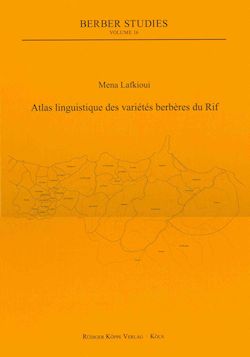


The Rif Berber varieties belong to the northern Berber languages and thus are part of the large Afro-Asiatic language phylum. They are spoken by the Rif Berber people in North Morocco, who are segregated from other Berber speakers: in the West by the varieties of Ktama (the so-called Senhaja varieties), in the South by the koinè of Gersif, and in the East by the varieties of the Iznassen, which have spread to the regions of Arabic speaking varieties to the Morocco-Algerian border.
Besides their complex phonological processes, which can influence morphological structures, the Rif Berber varieties are mostly known because of their extreme dialect differences. Linguistic variations analysed in the present book are mainly of horizontal or geographic types, nevertheless also vertical and diachronic types are linguistically analysed due to the relation between geographic diversity and temporal divergence.
Social and individual variations also affect geographic linguistic variation. Factors like social background, sex, age, social class and status belong to both the social and individual part, while the individual diversity additionally includes ideological-historical and psychological aspects.
The data were collected in the period summer 2001 – summer 2003, where the author spent a total of over nine months in the field covering a distance of over more than 400 km, visiting 452 villages of 36 tribes. Most of the varieties spoken in the Rif region are unknown or little documented in the Berber studies. In fact, this geographic area, mainly Berber speaking, is the least scientifically studied one of Morocco. Its economic and socio-political marginalisation, until nowadays, is one of the most significant factors of the lack.
The results and conclusions of the analyses of this book are presented in numerous geographic linguistic maps, showing the corresponding phenomena in context. This book is the first linguistic Atlas in the Berber studies and concerns the Rif area for the first time in Berber geolinguistics.
The Author published further books in the same series, see links below:
Historical linguists looking at innovations within Berber, typologists examining diversity, syntacticians looking at microvariation, anthropologists seeking to trace migrations – all will benefit greatly from this work, which makes it both possible and imperative to resist the temptation to say “Tarifit does so-and-so” in favour of a more nuanced account of variation within the Rif. [...] This work is, to the best of my knowledge, the most extensive atlas of dialect variation in Berber ever published, covering a far wider range of variables than Basset (1929, 1936, 1939), and will be an essential reference for anyone interested in linguistic variation within Berber or across North Africa as a whole.
Lameen Souag in Afrikanistik online, www.Afrikanistik-online.de/archiv/2007/1190, 1-2
[...] her [Lafkioui’s] book, rather than a scientific treatise of Berber dialectology, is an extremely interesting reference work. One that will probably and deservedly become a cornerstone for the study of Rif varieties of Berber.
Axel Fleisch in APAL Annual Publication in African Linguistics, 5/2007, 244-247
Khalid Mourigh in Journal of African Languages and Linguistics, 29/2, 2008, 254-256
© 2026 by Rüdiger Köppe Verlag – www.koeppe.de